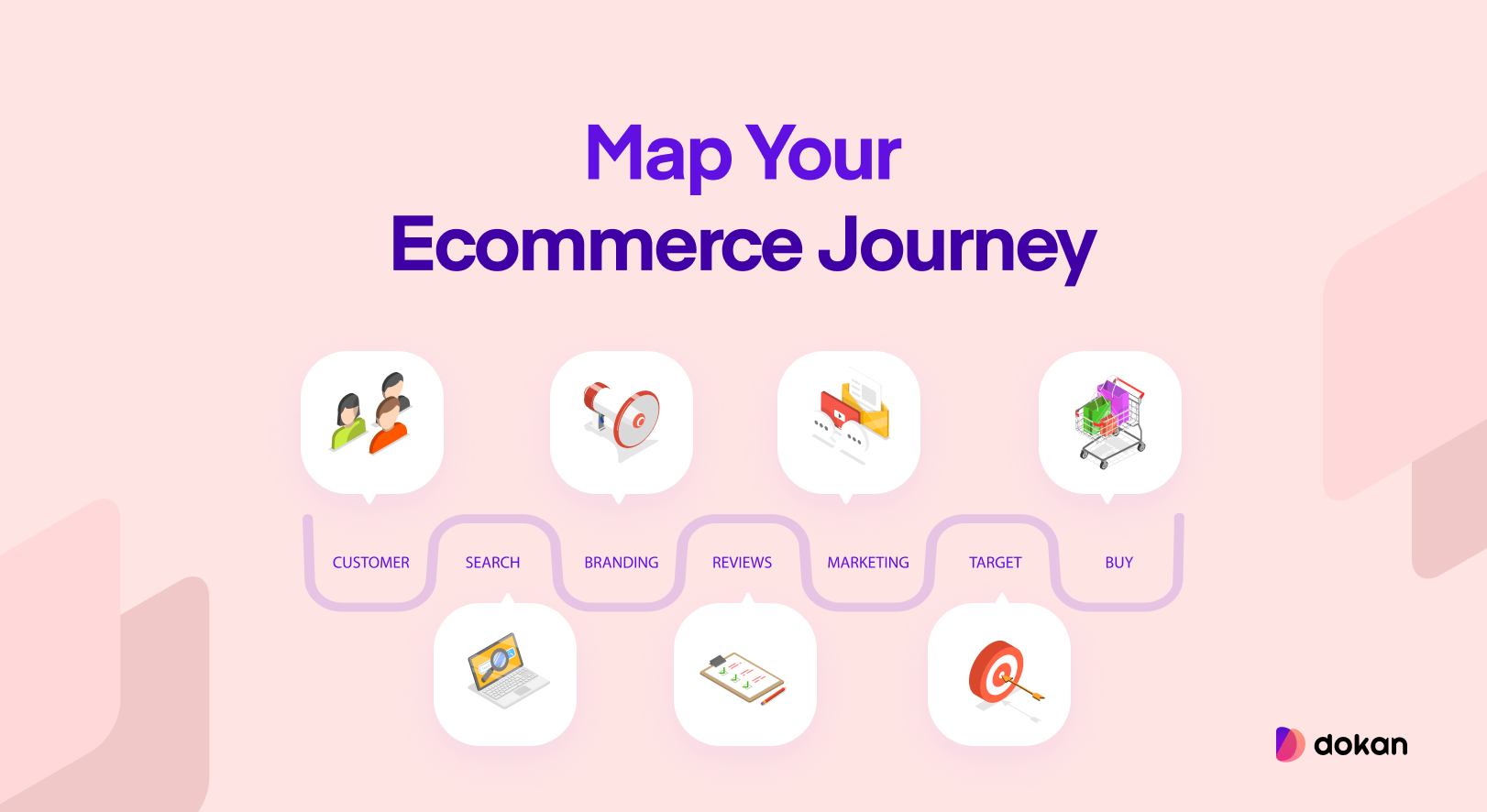Building an eCommerce website can be incredibly lucrative. More than 2+ billion buyers are constantly roaming around on online portals, marketplaces, and eCommerce sites to get their daily and seasonal products.
To harness this huge market opportunity, almost every day someone is coming up with a new eCommerce website from any part of the world. But soon after launching a website, people start realizing that the road is not so smooth.
There are more than 20 million active eCommerce websites on the web, but the success rate is considerably very low. Because most don’t have a clear idea of how to make their website stand out from the crowd and manage it rightfully.
This guide shows you the most essential things to consider when building an eCommerce website. Let’s dive into it.
What Are The Things to Consider When Building an eCommerce Website
Online buyers have a different sets of buying habits. Again, according to the product type, buyers differ in their buying habits as well. So, if you want to succeed in the eCommerce world, you must make sure of the following things on your website-
- Design a Website that Matches Your Product Niche
- Make It Responsive for All Devices
- Give It a User-Friendly Interface
- Add Easy Search Options
- Include Essential Pages
- Write Good Product Descriptions with Images
- Show Product Reviews and Ratings
- Add Multiple Payment Options
- Provide Multiple Shipping Options
- Allow Guest Checkout
- Take Good Care of Cybersecurity
- Ensure Right CMS Integration
Let’s explore them in detail.
1. Design a Website that Matches Your Product Niche
Your web theme, color, layout, and logos must be complementing the niche of products you are selling. Suppose, you are planning to launch a food-based eCommerce. You want to sell varieties of items, such as fast food, desserts, drinks, meals, and many others.

So, what should your website look like? Below is a snapshot of a USA-based eCommerce startup. It sells a variety of products in the home niche. Its web design is perfectly compatible with the niche. You can take it as an example to understand how your web design should look alike.
2. Make It Responsive for All Devices
Responsive web design makes it easy for online users to visit the eCommerce site from any device. According to Statista, more than 54% of global web traffic is coming only from mobile phones today. Besides, lots of people prefer to buy products using mobile phones to save time.
So, unless your website is responsive to mobile devices, you are going to miss out on a big market opportunity. How to make your website responsive? It’s quite very easy. Just get a web theme that has the responsiveness feature. Once you install and activate it, your website will automatically be responsive for all devices.
3. User-Friendly Interface
eCommerce websites usually have numerous products and multiple product categories. There are many separate pages as well for payment, shipping, contact information, and others. If your website isn’t properly organized, it may cause a waste of time for your online users. Below are the characteristics of a user-friendly interface:
- Clean design
- Easy navigation
- Clear CTA buttons and Links
- Eye soothing texts and fonts
- Dynamic information structure
- Contrasting color scheme
- First loading times
4. Make Sure Easy Search Options to Find Products
Once you go to Amazon, Alibaba, and other popular sites, you will find multiple filtering options on the search pages. Such as price, review, brand, location, and warranty type. This saves buyers time and helps them find out the product they are really looking for.

In addition to the search bars and filtering options, you must integrate the auto-complete search suggestion feature as well. Because it takes the user experience to another level.
5. Include Essential Pages
Indeed, quality product content is quite important for the success of an eCommerce site. But to present them properly, you need to create a number of pages. Also, you need to rely on these pages to provide a smooth shopping experience to the customers. Here are the must-have pages for an eCommerce website.
Homepage
The homepage works as the storefront of your website. When an online user comes to your website, they first land on this page. The homepage includes featured products, promotional messages, and top-selling products.
Category Page
The category page shows a number of grouped product items that are relevant to each other. The category page makes a bridge between the homepage and product pages.
Product Page
The product page shows an individual view of each product item. It includes prices, variations, shopping options, features, colors, measurements, reviews, and else. This is the page where customers decide whether to buy this product or not.
Shopping Cart
You need to create a dynamic shopping cart page that enables online users to pile up their desired products while exploring a website. After that, they can purchase these items together at a convenient time without going for them individually.

Payment
The payment page has several fields to let customers input their payment information. Afterward, this information is sent to the payment gateways to complete the payment procedure.
Many eCommerce websites allow exciting options on this page. Such as gift cards, promo codes, reward points, cashback options, discount coupons, etc.
Return & Refund Policy
Do you know around 30% of products ordered online are returned? This is why more than 80% of people avoid shopping from an eCommerce site that doesn’t have a return and refund policy. Amazon, Walmart, AliExpress, and other renowned eCommerce organizations follow a 7-14 day refund policy based on products.
However, you aren’t bound to refund customers if faults come from the customers’ end. But you need to make sure your customers about your return and refund policies in advance.
Login/Create Account
This page allows customers to subscribe, create user accounts on your page, and save their valuable information. It takes out the hassle of providing the same information over and over again during each purchase.
About us Page
The about us page helps the online customers know more about your business, where it is located, what types of products it sells, its mission, vision, business objectives, goals, how long it is in the market, etc. Also, you can include contact information (phone number, email, and social pages) on this page.

Foodpanda is a global online food delivery platform that is currently most popular in Asia. Below is a short clip of their About Us page which you can take as an example.
Terms & Conditions
If there are any exclusive rules and guidelines, not mentioned on any other page, can be elaborated on this page. This page usually defines the acceptable behaviors and legal terms that protect both the consumer rights and benefits of the business organization.
6. Write Engaging Product Descriptions
One of the biggest limitations of online shopping is that customers cannot check the product directly before purchasing it. All they do is depend on the information you tell about your products. This is why they give much importance to product description.
So, write your product description in an engaging way that none gets bored while reading. Don’t forget to specify the weight, length, and color of your items in the description. And never give false information in the product descriptions just to increase sales. Because it can harm your credibility.

Today, it’s very hard to find any eCommerce website without product photos. It is because high-quality graphics create an extra-dimensional appeal in customers’ psychology. So, you must include quality photos and videos in your product description as well. But make sure you aren’t violating the copyright issues.
7. Add Multiple Payment Options
Without having multiple payment solutions available, eCommerce websites cannot cater to a wider range of customers. When creating a website, look at which payment options are more popular with your target customers.
If you are doing online business in the USA, your payment option shouldn’t be limited to Visa or Mastercard. You must integrate PayPal, Stripe, and American Express as well. Again in India, popular payment systems are Razorpay, Instamojo, and Paypal.
8. Provide Multiple Shipping Options
According to Forbes, more than 60% of customers avoid love to buy products from a brand that doesn’t offer free shipping. Alongside, they want to get this delivery as soon as possible. But the cost of sellers substantially goes up when they try to provide fast delivery.

To solve this problem, many eCommerce portals today are providing multiple shipping options. It ranges from free shipping to DHL, FedEx, and UPS explaining their costs. It allows customers to choose the best shipping option that matches their time, value, and affordability.
9. Tace Good Care of Cybersecurity
When someone places an order on an eCommerce site, he has to provide lots of valuable information. Such as phone number, credit card number, email address, bank accounts, etc. Unless the security firewalls of a website are properly maintained, hackers can easily steal that valuable information.
Besides, Google never promotes those websites that don’t have SSL Certificates and HTTPS protocols. So, you must be careful about the security issues. Today, you will find numerous software and solutions to strengthen your website against malware attacks.
10. Allow Guest Checkout
The guest checkout allows online customers to place orders on the eCommerce website without registering an account there. Having the guest checkout option on a website can increase its conversion rate up to 45%.
Over the last few years, this system has become a lot popular around the world. Because customers no longer have to provide all their personal information to complete an order.
11. Collect Reviews from Your Users
Ratings and reviews refer to the customer feedback that they give after using a product. Positive reviews are just like gold to any online business. Because 87% of customers today conduct research online before buying a product.

They prefer to purchase those products that have better reviews and positive ratings. Reviews can be of different kinds: written reviews, short videos, product unboxing, and image content. So, you must allow your customers to put their valuable reviews under each of your product pages.
12. Ensure Right CMS Integration
Running a website is a complicated process. You have to add new products, publish blog posts, accept orders, verify payments, accept refund requests, update themes, and so on. If you aren’t a technical person, it will be difficult to manage a website without a content management system.
The content management system is a simple toolbox that gives you all the necessary options on a centralized platform to create, edit, format, and publish your web content. Popular CMSs are WordPress, Wix, OpenCart, and Magento. Better you use any of these CMSs to manage your website.
These are the most important things to consider when building an eCommerce website. It will increase the possibility of success in this sector.
FAQs Related to eCommerce Website Development
Here, we are going to cover the most frequently asked questions regarding the things to consider when building an eCommerce website.
What are the four types of eCommerce?
The four types of eCommerce are:
i) B2C (Business-to-Consumer)
ii) B2B (Business-to-Business)
iii) C2B (Consumer-to-Business)
iv) C2C (Consumer-to-Consumer)
Which eCommerce type is the most successful?
Business to Consumer (B2C) is the most successful eCommerce type.
What top 5 features are a must for any eCommerce site?
The top 5 must-have features for any eCommerce site are:
i) Responsive design
ii) High-quality visuals
iii) User-friendly navigations
iv) FAQ section
v) In-depth product descriptions
Before Ending on Things to Consider When Building an eCommerce Website
eCommerce is a dynamic platform. Whether you have your own eCommerce store, or you’re thinking about creating one, it’s important to know the things without which you cannot succeed in this industry.
Most people join this industry with much hope but limited homework. This is the reason why many of them crumble down within the first few months of their journey. Indeed, the number of eCommerce websites is increasing day by day.
But don’t worry. The number of people knowing to do it rightfully isn’t many. So, you always have a chance to take advantage of this immense market opportunity once you can learn how to perform here.
Hopefully, this article has helped you to unfold the things that you need to make sure to make your eCommerce stand out from the crowd.






Leave a Reply